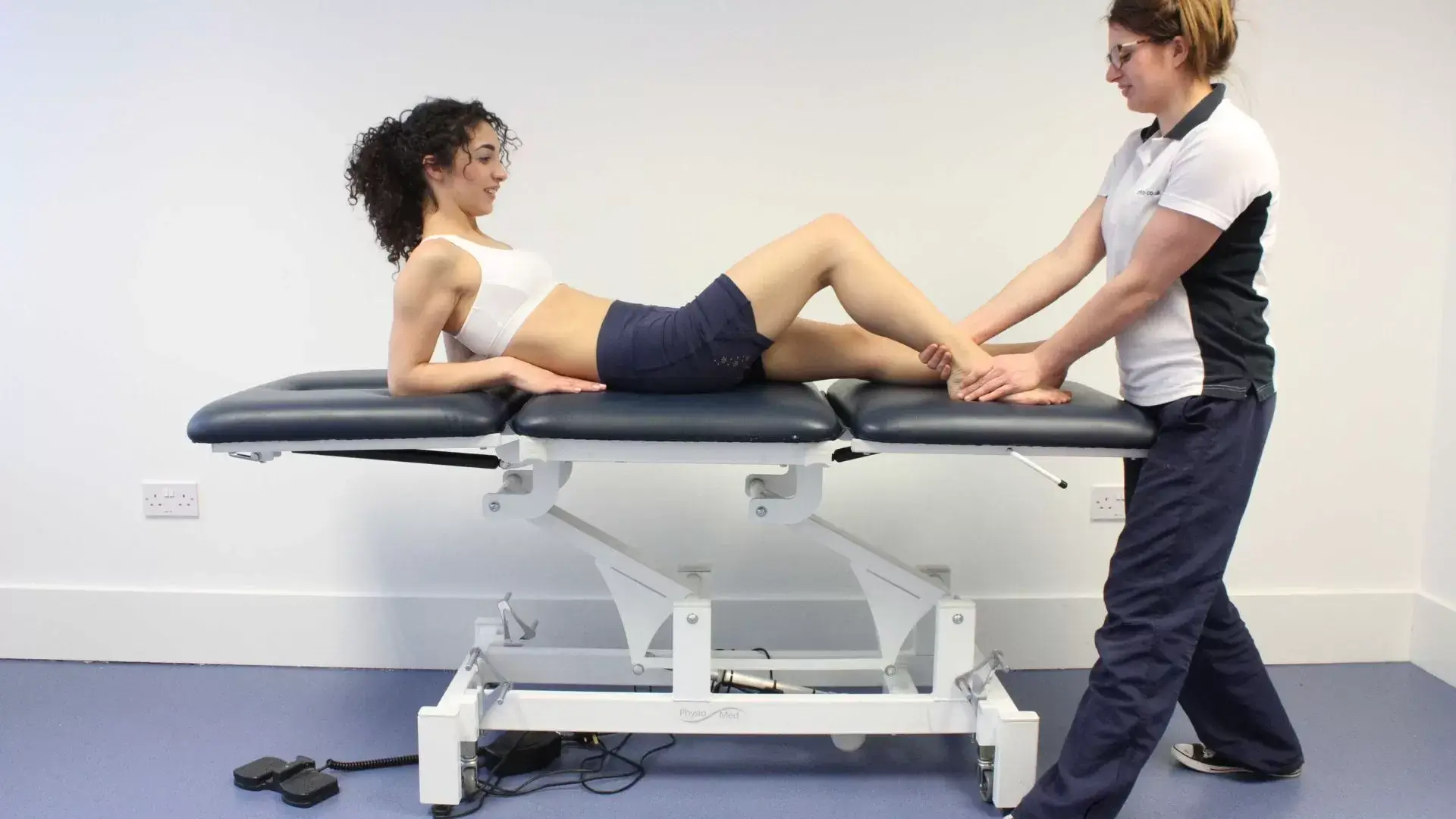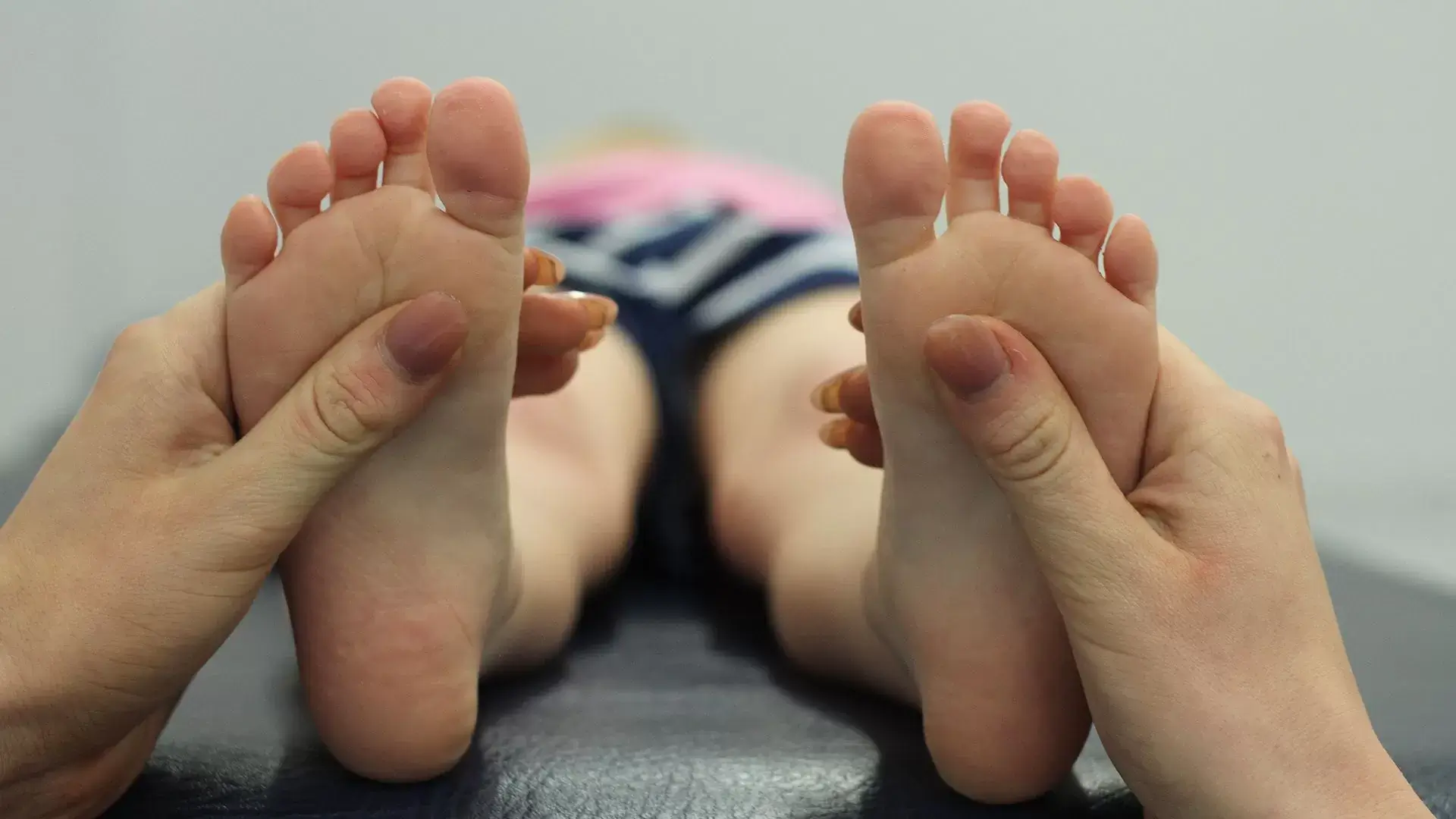In Mississauga, we offer specialized physiotherapy for clubfoot treatment, providing individualized approaches to enhance recovery and mobility for children. We focus on techniques like the Ponseti Method, which involves gentle manipulation and casting, combined with targeted exercises to strengthen the foot and ankle. Our experienced physiotherapists utilize foot orthotics and braces to guarantee proper alignment and prevent relapse. We’re committed to supporting families throughout this journey, encouraging home-based exercise programs for continued progress. By exploring our services, you’ll discover how we can help foster better outcomes for your child’s health and mobility.

At Mississauga Physio Chiro Clinic, we specialize in providing extensive physiotherapy and chiropractic services tailored to effectively address the unique needs of individuals with clubfoot, also known as congenital talipes equinovarus. Our goal is to promote ideal mobility and function through a thorough approach that includes physical therapy, pediatric physiotherapy, and early intervention strategies.
We focus on personalized treatment plans that incorporate gait training, muscle strengthening, and ankle mobility exercises to enhance stability and coordination. Our team of experienced professionals collaborates with families to guarantee that children receive the necessary support as they grow. We also emphasize the importance of corrective footwear, which plays a crucial role in managing clubfoot and promoting healthy foot alignment.
Through our Best Physiotherapy and Chiropractic Services in Mississauga, we aim to alleviate discomfort and improve overall quality of life for our patients. We believe that early intervention can greatly impact a child’s development and help prevent further complications associated with clubfoot. By working closely with families, we endeavor to empower them with knowledge and resources, assuring they feel supported throughout their journey in managing this condition.
What causes clubfoot, and what types and risk factors should we be aware of as we seek to understand this congenital condition? Clubfoot, a common congenital foot deformity, can primarily manifest in three types: idiopathic clubfoot, positional clubfoot, and syndromic clubfoot. Idiopathic clubfoot occurs without any identifiable cause, while positional clubfoot often results from intrauterine positioning, where the baby’s feet are compressed in the womb. Syndromic clubfoot is associated with neuromuscular disorders or other syndromes.
Genetic factors play a significant role in the occurrence of clubfoot, with a family history of clubfoot increasing the likelihood of its development. Prenatal diagnosis can sometimes identify clubfoot through ultrasound, allowing for earlier interventions and preparations.
We should also be aware that foot malformations can vary in severity, affecting treatment approaches. Understanding these causes, types, and risk factors helps us support families facing this condition. By addressing these factors, we can foster a more informed and empathetic approach to managing clubfoot, ensuring affected families feel supported throughout the journey.
Understanding the complexities of clubfoot lays the groundwork for recognizing how physiotherapy can play an essential role in treatment and recovery for affected individuals. Physiotherapy for clubfoot focuses on enhancing mobility and improving foot function through tailored rehabilitation programs. We emphasize the importance of dorsiflexion exercises, which help restore the ankle’s range of motion, and tibialis anterior strengthening to support the foot’s proper alignment.
Incorporating peroneal muscle training is vital for stabilizing the foot during movement, while achilles tendon stretching addresses tightness that may hinder mobility. The use of foot orthotics can further aid in correcting positioning, providing necessary support during the rehabilitation process. Additionally, we often integrate walking aids to facilitate safe ambulation as patients progress.
Prenatal detection of clubfoot through advanced imaging techniques allows for timely intervention planning, while postnatal assessments confirm the diagnosis and guide subsequent treatment strategies. Ultrasound detection during fetal development helps identify potential cases of bilateral and unilateral clubfoot, providing essential information for expectant parents. Understanding the influence of prenatal teratogens is also important, as they may contribute to the condition’s occurrence.
After birth, a thorough postnatal assessment is critical for diagnosing clubfoot, including evaluating the foot’s position and movement. In some instances, we may encounter neuromuscular clubfoot, which requires different management strategies. Additionally, we should remain vigilant for associated conditions, such as developmental dysplasia of the hip, which could complicate treatment.
Genetic counseling may be beneficial for families with a history of clubfoot, as it can help address concerns about clubfoot recurrence in future pregnancies. By integrating prenatal and postnatal evaluations, we can guarantee a complete approach to diagnosing clubfoot. This thorough process not only supports families but also lays the groundwork for effective treatment strategies, ultimately improving outcomes for affected infants.

The Ponseti Method is a highly effective, evidence-based approach to treating clubfoot, emphasizing the important role of physiotherapy in achieving ideal outcomes for affected infants. This method typically begins with serial casting to gradually correct the foot’s position. As physiotherapists, we guide families through this process, guaranteeing proper casting techniques are followed and that the infant’s progress is closely monitored.
In many cases, an Achilles tenotomy may be necessary to enhance the correction and allow for optimal foot function. Post-procedure, foot bracing becomes essential to maintain the alignment achieved during treatment. We work with families to guarantee they understand the importance of consistent bracing to prevent clubfoot relapse.
In addition to bracing, we incorporate stretching exercises that promote flexibility and strength in the foot and ankle, which is key in pediatric orthopedic treatment. Addressing potential gait abnormalities early on is part of our holistic approach to podiatric care. By closely collaborating with pediatricians and orthopedic specialists, we create a thorough treatment plan that minimizes the likelihood of requiring orthopedic surgery in the future, fostering a supportive environment for both the child and their family.
Incorporating targeted stretching and strengthening techniques is essential for enhancing foot function and overall mobility in children with clubfoot. Through physiotherapy, we can effectively address specific deformities such as equinus deformity, varus deformity, cavus foot, and adductus foot. By implementing these techniques, we aim to improve muscle balance, joint flexibility, and range of motion.
Stretching techniques focus on lengthening tight muscles and soft tissues around the foot and ankle, which is fundamental for correcting deformities. For instance, we often work on the Achilles tendon to alleviate equinus deformity and promote dorsiflexion. Strengthening techniques, on the other hand, help develop the intrinsic and extrinsic muscles of the foot, which can enhance stability and support proper alignment.
In conjunction with postural therapy and the use of ankle-foot orthosis, these techniques play an important role in preparing the child for potential surgical correction, if necessary. Together, we can foster improved foot function, ensuring that children with clubfoot can achieve greater mobility and a better quality of life. Regular assessment and adaptation of these techniques are important to meet the evolving needs of each child as they grow.
Foot bracing and orthotic solutions are crucial components in the management of clubfoot, providing the necessary support to maintain proper alignment and facilitate long-term correction. For children diagnosed with this congenital musculoskeletal disorder, we often recommend the use of devices like the Dennis Browne splint or the Steenbeek foot abduction brace. These orthotic solutions are designed to address equinovarus correction and prevent plantarflexion restriction, which are critical for ideal foot function.
In cases of neglected clubfoot, where initial treatments may have been insufficient, these braces are especially important. They help in gradually realigning the foot while also allowing for soft tissue release where necessary. By employing these foot bracing techniques, we can promote a more effective recovery, ensuring that the foot maintains its corrected position during growth.
As we support families through this journey, we emphasize the importance of consistent use of these orthotic solutions. With commitment and proper guidance, we can achieve lasting correction for children affected by clubfoot, greatly improving their ability to engage in everyday activities and enhancing their overall quality of life.
Addressing clubfoot relapse requires targeted physiotherapy interventions that focus on strengthening muscles, improving range of motion, and enhancing overall foot function. When we encounter relapse, it’s essential to evaluate the underlying causes, which may result from previous treatments like tendon transfer, posteromedial release, or talectomy. Each individual’s experience with clubfoot is unique, especially in cases linked to conditions such as cerebral palsy, arthrogryposis, or amniotic band syndrome.
Our approach involves tailored physiotherapy programs that emphasize not only correcting foot positioning but also building strength in the surrounding musculature. This can greatly aid in preventing future relapses. We utilize exercises designed to improve flexibility and stability, ensuring that the foot can withstand daily activities without reverting to previous deformities.
Furthermore, we encourage regular follow-ups to monitor progress and make necessary adjustments to the treatment plan. By doing so, we create a supportive environment that empowers families and patients alike. With our combined efforts in targeted physiotherapy, we can effectively manage clubfoot relapse, helping each patient achieve ideal foot function and mobility. Together, we can navigate this journey towards lasting improvement and quality of life.

Effective gait training is crucial for enhancing mobility in clubfoot patients, as it directly impacts their ability to navigate daily activities with confidence and stability. Through targeted physiotherapy, we can address the unique challenges faced by individuals with twisted feet, inward feet, and downward feet. Our goal is to correct gait patterns, ensuring proper alignment and function.
For those with untreated clubfoot or conditions like Larsen syndrome, the significance of early intervention cannot be overstated. We utilize evidence-based techniques, including the Ilizarov method, to facilitate mobility enhancement. This method allows for gradual correction of foot positioning, which is essential for effective gait training.
In our sessions, we focus on strengthening exercises, balance training, and coordination activities tailored to each patient’s needs. By fostering these skills, we help improve their overall gait mechanics, leading to better mobility outcomes. Additionally, we provide guidance on assistive devices when necessary, ensuring that every individual can progress toward independence. Ultimately, our approach aims to empower clubfoot patients, helping them achieve their mobility goals and enhancing their quality of life through thorough physiotherapy.
When considering physiotherapy for clubfoot, we recognize the significance of tailoring our approach to accommodate both surgical and non-surgical methods, ensuring that each patient receives the most suitable care for their unique condition. For patients diagnosed with CTEV (congenital talipes equinovarus), our team at 1834 Lakeshore Rd W #6C, Mississauga, ON L5J 1J7, is dedicated to providing a thorough treatment plan that addresses individual needs.
For non-surgical approaches, we often utilize methods such as the Ponseti technique, which involves gentle manipulation and casting. These techniques are especially effective for infants born with clubfoot due to factors like oligohydramnios or breech presentation. Our experienced physiotherapists collaborate closely with families to guide them through each step.
In cases where surgical intervention is necessary, we focus on post-operative rehabilitation to promote ideal recovery and mobility. This is particularly crucial for patients with additional conditions like myelomeningocele, where tailored physiotherapy can enhance overall functional outcomes.
Pediatric physiotherapy strategies for clubfoot rehabilitation must be carefully designed to foster ideal recovery and functional development in young patients. We start by evaluating each child’s specific needs, taking into account their age, severity of the condition, and overall health. Early intervention is essential, and we often implement a combination of targeted exercises, manual therapy, and functional activities to improve mobility and strength.
We focus on gentle stretching techniques to enhance flexibility in the affected foot and ankle, guaranteeing we avoid any undue stress. As the child progresses, we incorporate strengthening exercises to build stability and support. Using play-based activities helps engage young patients in their rehabilitation, making sessions enjoyable and effective.
Additionally, we emphasize educating families about the importance of adherence to therapy and the use of orthotic devices. We encourage parents to be active participants in their child’s rehabilitation, guiding them on how to assist with exercises at home. Our collaborative approach guarantees that we address not just the physical aspects but also the emotional needs of both the child and the family, fostering a supportive environment for recovery.
Addressing clubfoot in children with neuromuscular disorders requires a tailored therapeutic approach that considers both the complexities of the condition and the unique challenges these patients face. We recognize that children with neuromuscular disorders may experience varying degrees of muscle tone, strength, and coordination, impacting their mobility and the management of clubfoot.
In our therapy sessions, we prioritize individualized assessments to understand each child’s specific needs. We implement a combination of stretching, strengthening exercises, and manual therapy techniques designed to improve foot positioning and overall function. By focusing on enhancing muscle control, we help facilitate better alignment and movement patterns.
Additionally, education plays a significant role in our approach. We work closely with families to guarantee they understand the importance of consistent therapy and home exercises. This collaborative effort fosters a supportive environment, empowering parents to actively participate in their child’s rehabilitation journey.
Ultimately, our goal is to optimize functional outcomes while addressing the broader implications of clubfoot in the context of neuromuscular disorders. Through dedicated and personalized therapy, we aim to enhance each child’s quality of life and mobility, allowing them to reach their fullest potential.
Incorporating postural therapy and walking aids into our treatment plans can substantially enhance mobility support for children dealing with clubfoot, particularly those with neuromuscular disorders. Postural therapy focuses on correcting alignment and improving muscle function, which is fundamental for effective movement. By addressing these aspects, we help children develop better balance and coordination, essential elements for walking and participating in everyday activities.
Walking aids, such as orthotics and specialized footwear, play an important role in providing stability and support. These devices can alleviate pain and reduce the risk of injury, allowing children to practice walking with confidence. We often recommend a combination of postural therapy exercises and walking aids tailored to each child’s unique needs, ensuring they receive thorough care.
As we implement these strategies, we monitor progress closely, making adjustments as necessary to optimize outcomes. Our goal is to empower children by enhancing their mobility and independence, fostering a more active lifestyle. By focusing on both postural therapy and the appropriate use of walking aids, we can make significant strides in improving the quality of life for children affected by clubfoot.
Home-based exercise programs can play an essential role in maintaining long-term foot health for children with clubfoot, allowing families to actively participate in their child’s rehabilitation journey. These programs provide a structured approach to reinforcing the gains made during clinical therapy, ensuring that the child’s foot remains flexible and strong as they grow.
We can implement a variety of exercises tailored to our child’s specific needs, focusing on stretching, strengthening, and improving overall coordination. Regular practice of these exercises not only aids in maintaining the correct foot position but also encourages the development of muscular balance. Engaging in these activities together fosters a supportive environment, enhancing our child’s motivation and adherence to the program.
It’s crucial to monitor our child’s progress and adjust the exercises as necessary, ensuring they remain challenging yet achievable. By collaborating with our physiotherapist, we can establish a routine that fits seamlessly into our daily lives, making it easier for our child to integrate these exercises. Ultimately, committing to a home-based exercise program is a proactive step towards securing our child’s long-term foot health and overall well-being.
Preventing future mobility challenges in individuals with clubfoot requires a proactive approach that emphasizes early intervention and ongoing physical therapy. We understand that when clubfoot is treated promptly, the likelihood of developing additional mobility issues markedly decreases. It’s essential for us to recognize that the foundation of effective treatment lies in consistent physiotherapy, which helps to strengthen the foot and improve its range of motion.
Moreover, engaging in tailored exercises is imperative. These exercises not only enhance flexibility but also promote proper gait patterns. As we work together with healthcare providers, we can guarantee that individuals with clubfoot learn the importance of maintaining an active lifestyle. Regular monitoring and adjustments to exercise programs are essential to accommodate growth and changing needs.
Furthermore, education plays a pivotal role in preventing future challenges. We can empower families with knowledge about the condition, guiding them on how to support continued progress at home. By fostering a collaborative environment between patients, families, and healthcare professionals, we can build a solid foundation for lifelong mobility and overall well-being. Together, we can make a considerable difference in the lives of individuals affected by clubfoot.
Accessing expert physiotherapy care for clubfoot in Mississauga is essential for guaranteeing effective treatment and long-term mobility outcomes. We acknowledge that the journey with clubfoot can be challenging, but with the right support, we can help facilitate ideal recovery. Our specialized physiotherapy services focus on individualized treatment plans tailored to each patient’s specific needs.
In Mississauga, we have a team of experienced physiotherapists who are well-versed in the latest techniques and practices for managing clubfoot. We aim to address not only the physical aspects of the condition but also the emotional and psychological well-being of our patients. Through a combination of therapeutic exercises, stretching, and manual therapy, we work collaboratively to improve mobility, strength, and overall function.
Additionally, we provide education for families, empowering them to actively participate in their loved one’s treatment journey. By creating a supportive environment, we foster confidence and resilience in both patients and their caregivers. Our commitment to excellence guarantees that every individual receives the highest standard of care, helping them achieve their mobility goals. Let’s take this important step together toward a healthier future. Contact us today!
Mississauga, the sixth-largest city in Canada, offers a vibrant community rich in resources and support for individuals seeking treatment for conditions like clubfoot. We’re fortunate to have access to a variety of healthcare facilities, including specialized physiotherapy clinics and hospitals, all equipped with advanced technologies and trained professionals who understand the complexities of clubfoot treatment.
As a diverse city, Mississauga boasts a multicultural environment that fosters inclusivity and understanding, which is vital for families maneuvering the challenges of clubfoot. We have numerous support groups and community organizations dedicated to educating and assisting families, ensuring they feel supported throughout their journeys.
In addition to healthcare services, Mississauga provides recreational and educational resources that can benefit children undergoing treatment. Local parks, sports programs, and community centers promote physical activity, which is essential for development and recovery.

When considering the best age to start physiotherapy for clubfoot, we’ve found that early intervention, ideally within the first few weeks of life, is vital. Starting treatment early can greatly improve outcomes, allowing for better foot positioning and mobility. We recognize that each case is unique, so it’s important to consult with a specialist to determine the most appropriate timing for each individual child’s therapy needs. Early action can lead to lasting benefits.
When considering physiotherapy treatments for clubfoot, it’s important to recognize that, like any therapeutic intervention, there are potential risks. These can include discomfort during exercises, skin irritation from splints or braces, and, in rare cases, complications from improper technique. However, we can mitigate these risks through careful monitoring and tailored treatment plans. Overall, the benefits of physiotherapy in promoting mobility and function often outweigh the potential challenges we might face.
To support our child’s physiotherapy journey at home, we can create a consistent routine that incorporates prescribed exercises and stretches. It’s crucial to maintain open communication with our child, encouraging them and celebrating their progress. We should also guarantee they have a comfortable and safe space for practice. Additionally, we can educate ourselves on the treatment process, so we’re equipped to address any challenges and reinforce the importance of their therapy.
When we consider the expected timeline for clubfoot recovery with physiotherapy, it generally varies based on individual cases. Typically, we can anticipate noticeable improvements within a few weeks, but full recovery may take several months. Regular assessments will help us track progress and adjust treatment as needed. It’s essential for us to stay committed to the therapy plan, as consistent effort plays a vital role in achieving the best possible outcomes for our children.
There are indeed specific physiotherapy clinics that specialize in treating clubfoot. When we’re looking for the right place, we should consider clinics that have a proven track record and experienced professionals. It’s crucial to confirm the staff understands the unique needs of clubfoot therapy. We can also check for patient reviews and success stories to help guide our decision. Together, we can find the best support for recovery and rehabilitation.
Reach out to us today to book an appointment or learn more about our services. Our friendly team is here to answer your questions and help you take the first step toward improved health and wellness.
(647) 372-1209

At our Mississauga Physio Chiro Clinic, we are dedicated to providing personalized care that addresses the root cause of your discomfort. With a team of experienced physiotherapists and chiropractors, we focus on restoring your mobility, relieving pain, and enhancing your overall well-being.